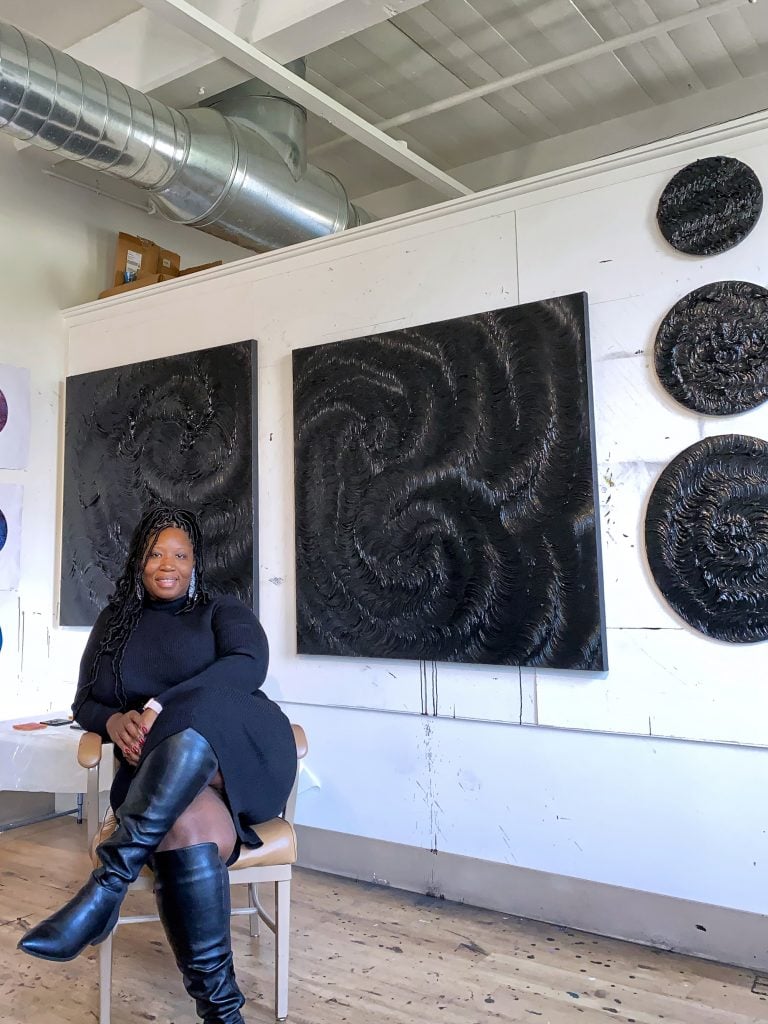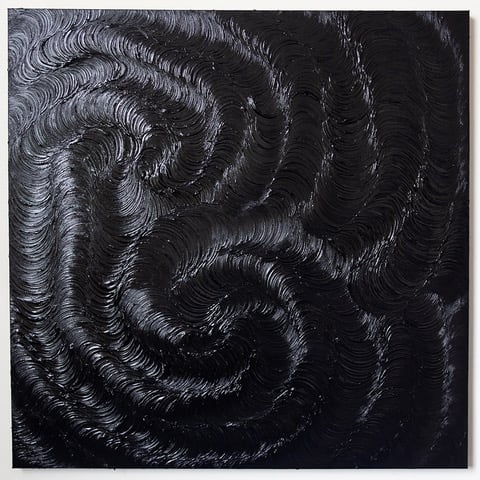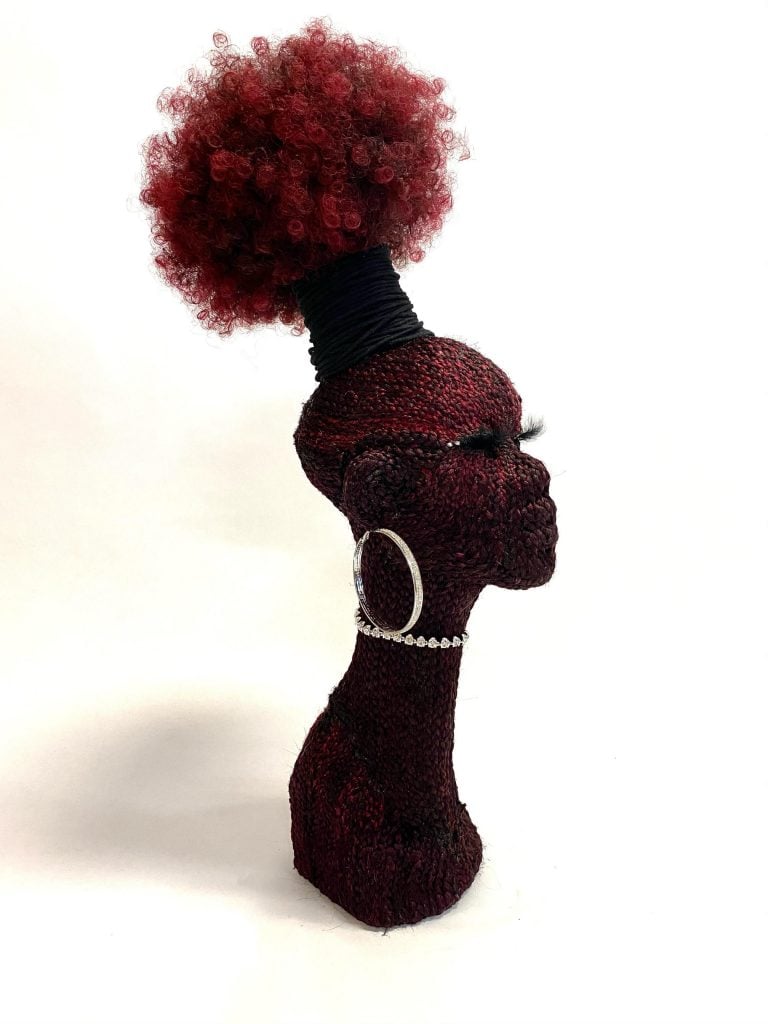Table of Contents
Black hair is—and has always operated as—a form of identity. In early African cultures, hairstyles signified a person’s tribe, social status, or family history. However, the pernicious effects of colonialism later shifted how Black hair was viewed. In the new hierarchy that emerged, European features were valued and kinky hair and coils were ridiculed.
For centuries, negative perceptions associated with natural hair compelled Black individuals to change their hair to conform to a white majority as a form of survival. Altering their natural hair texture helped Black individuals move through society more easily under the white gaze; a straight and smooth look aided in social mobility and job security. It wasn’t until the 1960s and ’70s, when the Black Power movement emerged, that Black individuals began to reclaim their lost heritage and publicly celebrate their beauty.
Over the decades, artists have found inspiration in Black hair—from Lorna Simpson’s “Wigs” series to Nigerian photographer J.D. ’Okhai Ojeikere’s documentation of intricate, sculptural braids up to Zanele Muholi’s celebratory portraits. The three contemporary practitioners profiled below—all with family ties to the vital traditions of barbering and beauty salons—are likewise using shape, form, and texture to amplify the beauty of Black hair unaltered.
During an era when standards of dress are shifting, the definition of professionalism is being debated, and rules on natural hair are being regulated, the work these young artists are producing is even more timely and necessary.
Shaina McCoy
Shaina McCoy in her studio. Photo: Fadumo Ali. Courtesy of the artist.
Minneapolis-based figurative painter Shaina McCoy (b.1993) works predominantly in oils to highlight the importance of everyday people in her community. Her signature faceless figures force you to pay attention to the features and environment in her portraits to understand her subjects in their entirety. Referencing her family’s old photographs, the self-taught artist uses a variety of materials such as paintbrushes or toothpicks to create layered, texturized surfaces. In her series “B is For” (2021), McCoy captures the essence of Black girlhood by focusing on traditional hairstyles. Bobbles, barrettes, and bows—“B” is for the small hair accessories that universally resonate in Black American households. Through iconography and color palette, McCoy is able to translate a feeling of nostalgia by recreating those familiar looks. McCoy told Artnet News in a recent interview, “Hairstyles allow us to be ourselves and have the individuality to embrace our beauty—because for so many years we were told that we couldn’t.”

Shaina McCoy, Tesha (2021) and Bobbles (2021), from the “B is For” series. Courtesy of the artist.
Barbershops and hair salons have traditionally played a huge role in Black culture beyond strictly grooming and physical upkeep. McCoy’s father worked as a barber, and she recalls how impactful the barbershop’s sense of community and family was to her during her younger years. To highlight that life stage, McCoy said, “This was a good series to put out there, because it’s a common story that I can re-share with the world, between Black girls. It’s important to create a series like this, to have mirrors, so I can reflect the times and reflect the people. I don’t want our people to be erased. I want folks to know that we’re here and we’re not going anywhere.” McCoy is currently preparing for her fourth solo exhibition, “Cadillac4,” at Galeria Duarte Sequeira in Braga, Portugal, opening April 9.
Ashanté Kindle

Ashanté Kindle in her studio. Courtesy of the artist.
Rhythm and repetition serve as a form of recovery and remembrance for Connecticut-based artist Ashanté Kindle (b. 1990), who celebrates the beauty of Black hair in abstracted paintings that resemble natural and stylized hair textures. Recreating patterns like an S curl or waves, Kindle invents a visual language that is easily recognized in the Black community. Working with heavy-body acrylic paints, Kindle employs a variety of different tools, including hairbrushes from the Sally Beauty Supply store, in combing motions to add hair-like texture to her paintings. Her practice is partly inspired by her aunt, a beautician; in making the comparison between art-making and hairstyling, she sees “how beauticians give a part of themselves to every client” in the same way she does with each painting.

Ashanté Kindle, Soft ripples into velvet waves (2021), currently on view in the exhibition “A Dream Transformed” at the University of Connecticut’s Jorgensen Gallery in Storrs. Courtesy of the artist.
Kindle’s all-black series amplifies the sufficiency in the Black community; as she stated in a recent Zoom interview with Artnet News, “I use all black paint because it’s enough. I’m not necessarily trying to be more sophisticated. Black is enough, Black people are enough…To identify as Black, it’s more to do with a culture and a connection to people, even outside of this country. Blackness exists all over the world, and that’s something that we share all together.” Kindle’s works address the freedom, confidence, and privilege it takes to be able to wear your hair freely without restraints. Her current show, “A Dream Transformed,” is on view at Jorgensen Gallery at the University of Connecticut—where she is completing her MFA—in Storrs through March 25.
Murjoni Merriweather

Murjoni Merriweather, T R A E (2021). Courtesy of the artist.
Modeling her distinctive sculptures on close friends or even herself, Baltimore-based artist Murjoni Merriweather (b. 1996) emphasizes the beauty of distinguished facial features and hair texture—in no small part to combat the harmful stereotypes that expose her real-life subjects to racial profiling beyond her studio walls. Currently working between two sculpted styles—raw ceramics, and ceramics with synthetic braids glued to the surface—Merriweather explores the dualities and complexities in the Black community. Trained at the Maryland Institute College of Art, the artist incorporates beauty and pop culture into her work by adding lash extensions, earrings, and grills to her sculptures, making them almost lifelike. In a recent interview with Artnet News, she said that she purposely works in a larger scale so her work can take up the space it deserves: “I love my sculptures being big. I want us to take up spaces, because we belong here and we deserve to be everywhere that we are.”

Murjoni Merriweather, O Y A (2021). Courtesy of the artist.
Beyond the works’ imposing scale, she is also attuned to where and how they are displayed. She added, “I want my sculptures to stand out and be tall, and I want people to look up at them at eye level or higher—I don’t want people to ever look down on my sculptures, because I don’t want us to be looked down on.” Merriweather is currently showing in “Hues” at New York’s Hannah Traore Gallery through April 9.
Follow Artnet News on Facebook:
Want to stay ahead of the art world? Subscribe to our newsletter to get the breaking news, eye-opening interviews, and incisive critical takes that drive the conversation forward.
Meet 3 Contemporary Artists Who Use Innovative Techniques to Revel in the Beauty of Black Hair
 fashion rec fashion wanted
fashion rec fashion wanted
